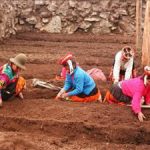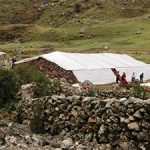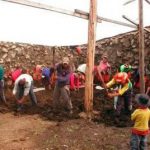Alma worked with Living Heart to make its successful nutritional programme more sustainable, with a pilot project to allow the community to grow fresh vegetables and herbs in the highland hamlet of Qhelqanqa, in collaboration with the Municipality of Ollantaytambo and the local primary school, building on the experience of other NGOs with greenhouses.
Qhelqanqa is an impoverished agrarian community of approximately 350 people (72 families), situated at around 4000m above sea level 3 hours by car above Ollantaytambo, Cusco. Many of the men in the community work as porters on the Inca Trail for 6 months of the year and the women and children are left to care for livestock and potato crops.
The community has a small school where Living Heart has been providing nutritious school meals and food for abandoned elderly people as well as health education and support via their Local Nurse. Many of the children had been malnourished and displayed low energy levels, both inside and outside the classroom. Others were not sent to school, but held back to work in the fields and care for the animals.
A health and nutrition programme was established to ensure that the children received two hot nutritious meals per day throughout the school year – resulting in healthier, more energetic children and higher school attendance levels. Fresh food is delivered once a fortnight and progress is monitored by a local representative and qualified nurse employed by Living Heart.
The diet in the high altitude communities is extremely limited and consists mainly of potatoes, supplemented occasionally with a little meat and fish. The climate, altitude, aspect and soil limit the productivity of the land in terms of crop yields and range of crops available. Extreme cold and regular frosts in the dry season prevent any vegetable, legume or cereal crops being grown. The people subsist on potatoes and their only contact with fresh vegetables and salad has been through the Living Heart food and nutrition programme. The adults in the community have seen the benefits the children are enjoying from a nutritious diet that includes vegetables and expressed their desire to access nutritional food for adults in the community (especially expectant mothers).
This project expands the benefits of good nutrition to preschool children, secondary school children, expectant mothers, and the parents and other adults of the community by building with them the infrastructure (a community greenhouse), capability and skills to cultivate their own fresh food for consumption in the household. A local technician will be employed to support and train the community and a local caretaker to be responsible for the project.
By providing education and practical training to the primary school children and supporting the community in this educational greenhouse project over the long term our goal is to pass over the responsibility and ability of providing a nutritious diet to the people themselves.
September 2011 Update
The project is moving along quickly. Ian from Alma and several people from Living Heart were in Quelcancha last week to meet with the community, set construction dates and begin siting the new greenhouse. Construction will begin Thursday, September 15. The community and the school children are very proactive and excited to get started on the project.
September 2012 Update
The greenhouse in Qhelqanqa has been providing vegetables to the school lunches for the community’s nursery and primary school students without outside assistance from Living Heart and minimal coordination from Alma since July of this year. The transition has been slow however, and community leaders are unsure of who should take responsibility, leaving coordination and control of the greenhouse to the school’s three teachers while the community organizes its roles. Nevertheless, the greenhouse is complementing the government PRONAA rations of rice and tuna with a variety of nutrient-rich vegetables such as carrots, spinach, cabbage, zucchini, cucumbers, broccoli, and coli flour. Parents also supply potatoes and fire wood, and student mothers are now voluntarily cooking on a rotational basis. The school’s Director, Maria Arroyo has recently cleared the greenhouse and began replanting the next batch of vegetables with the fifth and sixth grade students.
The new challenge for the greenhouse and the sustainability of the school lunches is the implementation of community coordination of the greenhouse. The teachers work in the community on a contractual basis for one school year. Therefore, the teachers will only be present in the community until the end of December. If the greenhouse is to continue functioning, the community must elect a group of responsible parents to coordinate the planting, harvesting, irrigation, and maintenance of the greenhouse. Alma will assure that this takes place by attending the community and Parents’ Association meetings to request a vote for the committee and by using our contacts within the community to verify that the community takes steps towards the independent coordination of the greenhouse.
November 2012 Update
The greenhouse is up and running. Vegetables are being cultivated, cooked and eaten. Our formal assistance has ended but Ian still visits the community regularly to ensure the program is self-sustaining.



